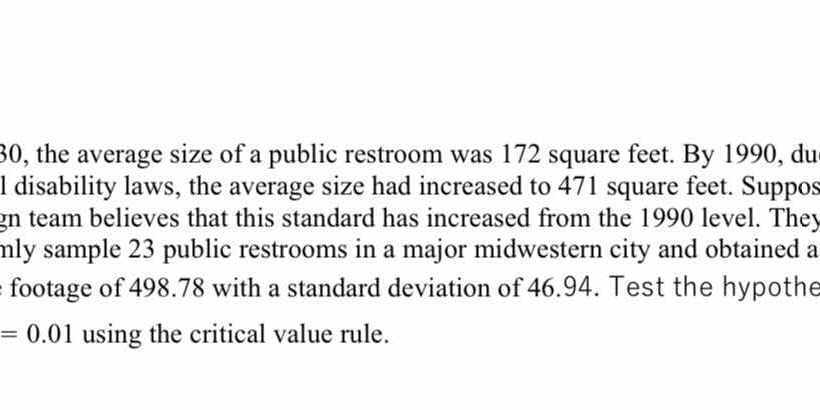In 1930, the average size of a public restroom was 172 square feet. By 1990, due to disability laws, the average size had increased to 471 square feet. Suppose a design team believ... In 1930, the average size of a public restroom was 172 square feet. By 1990, due to disability laws, the average size had increased to 471 square feet. Suppose a design team believes that this standard has increased from the 1990 level. They randomly sample 23 public restrooms in a major midwestern city and obtained a mean footage of 498.78 with a standard deviation of 46.94. Test the hypothesis at α = 0.01 using the critical value rule.

Understand the Problem
The question is asking to perform a hypothesis test to determine if the average size of public restrooms has increased from the 1990 value of 471 square feet. It provides sample data and a significance level to conduct the test using the critical value rule.
Answer
The null hypothesis is rejected; the average size of public restrooms has increased from 471 square feet.
Answer for screen readers
The null hypothesis is rejected, indicating there is significant evidence that the average size of public restrooms has increased from 471 square feet.
Steps to Solve
-
State the Hypotheses
The null hypothesis ($H_0$) is that the average size of public restrooms is equal to 471 square feet. The alternative hypothesis ($H_a$) is that the average size has increased, i.e., $H_a: \mu > 471$. -
Set the significance level and determine the critical value
The significance level ($\alpha$) is 0.01. Since we are conducting a one-tailed test, we will find the critical value for a z-test. From the z-table, the critical z-value for $\alpha = 0.01$ is approximately $2.33$. -
Calculate the test statistic
We use the formula for the z-test statistic:$$ z = \frac{\bar{x} - \mu_0}{\frac{s}{\sqrt{n}}} $$
where:
- $\bar{x} = 498.78$ (sample mean)
- $\mu_0 = 471$ (population mean under the null hypothesis)
- $s = 46.94$ (sample standard deviation)
- $n = 23$ (sample size)
Substituting the values:
$$ z = \frac{498.78 - 471}{\frac{46.94}{\sqrt{23}}} $$
-
Perform the calculations
First, calculate the standard error:$$ SE = \frac{46.94}{\sqrt{23}} \approx 9.78 $$
Now, calculate the z-test statistic:
$$ z = \frac{498.78 - 471}{9.78} \approx 2.85 $$
-
Make a decision
Compare the calculated z-value (2.85) with the critical value (2.33). Since $2.85 > 2.33$, we reject the null hypothesis. -
Conclusion
There is sufficient evidence at the $\alpha = 0.01$ significance level to support the claim that the average size of public restrooms has increased from the 1990 level.
The null hypothesis is rejected, indicating there is significant evidence that the average size of public restrooms has increased from 471 square feet.
More Information
This test highlights how public restroom sizes may reflect changing societal needs and compliance with new standards, such as those driven by disability laws. The increase in average size suggests an evolution in accessibility standards.
Tips
- Not understanding one-tailed vs two-tailed tests: In this scenario, since we are only testing if the size has increased, it’s a one-tailed test.
- Forgetting to calculate the standard error: It’s essential to compute the standard error to get the correct z-value.
- Misinterpreting the critical value: Ensure to compare the calculated z-value against the correct critical value for the specified significance level.
AI-generated content may contain errors. Please verify critical information